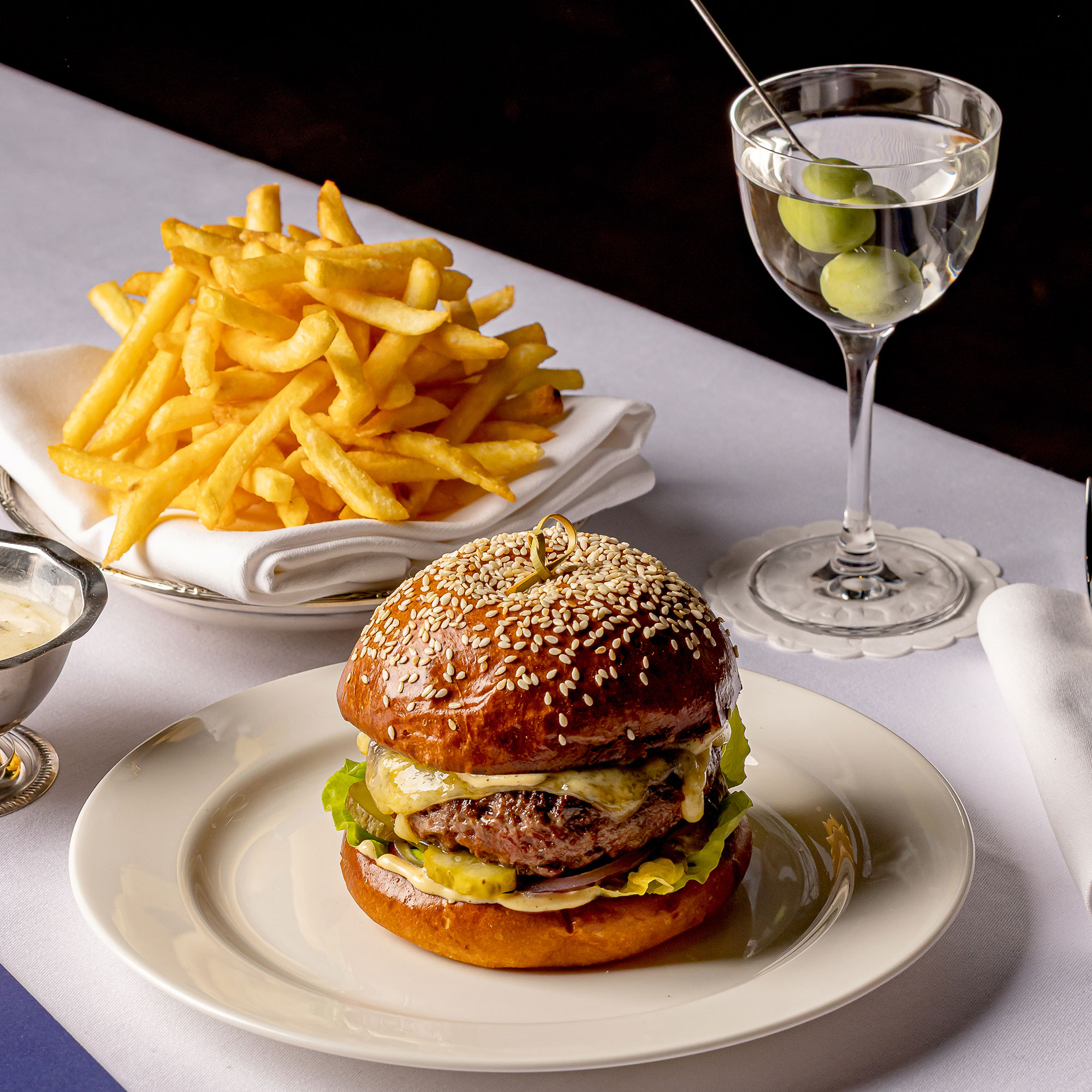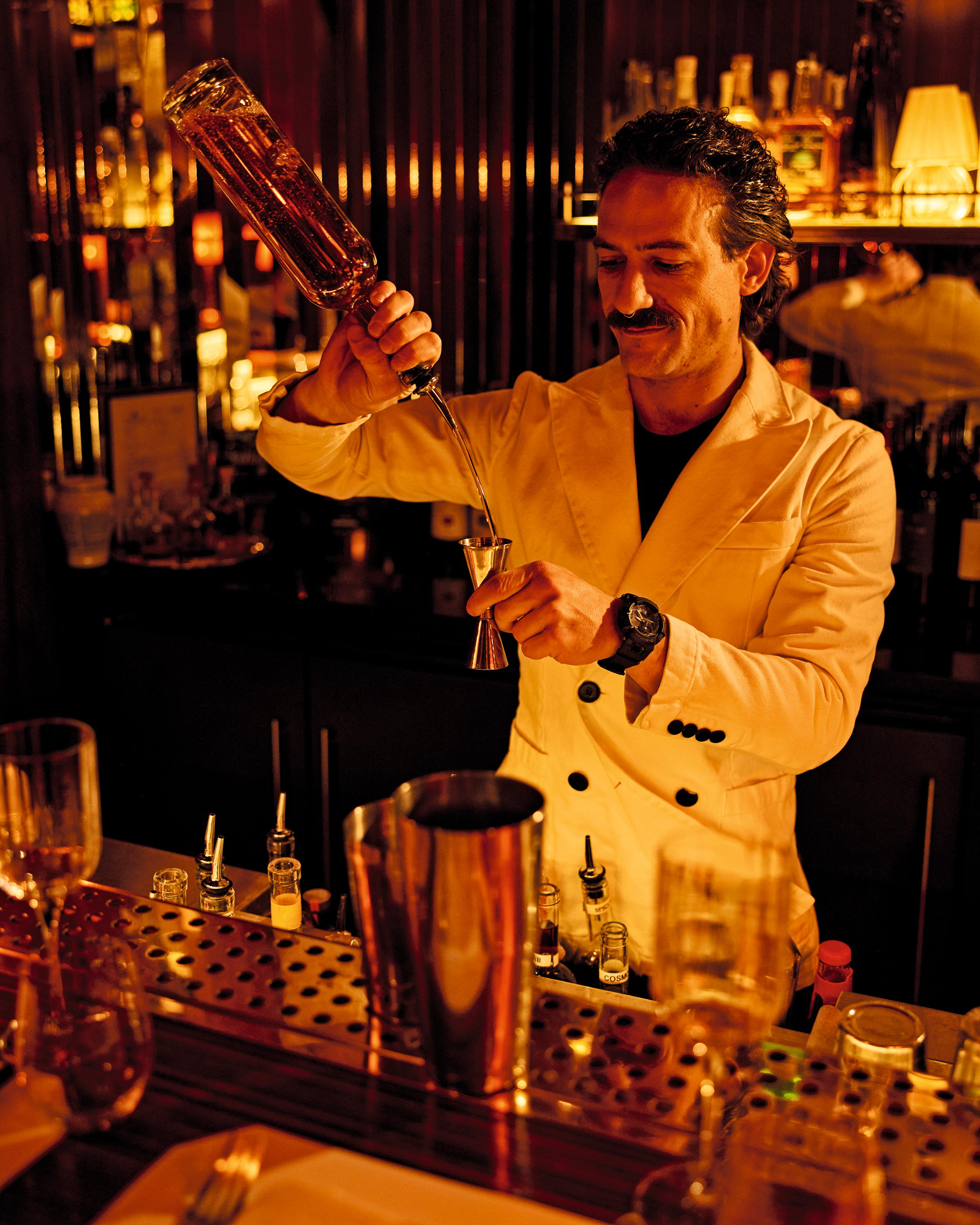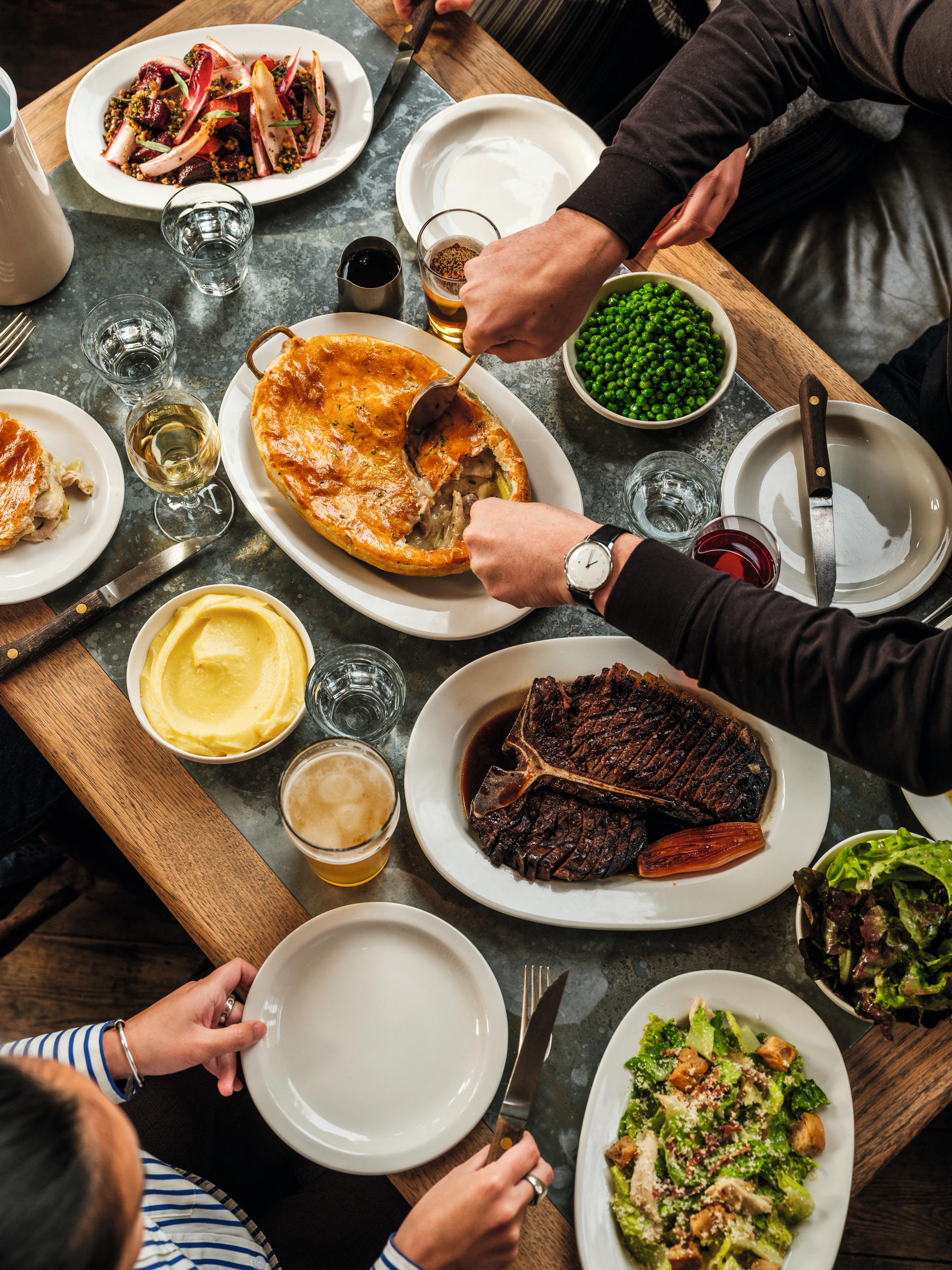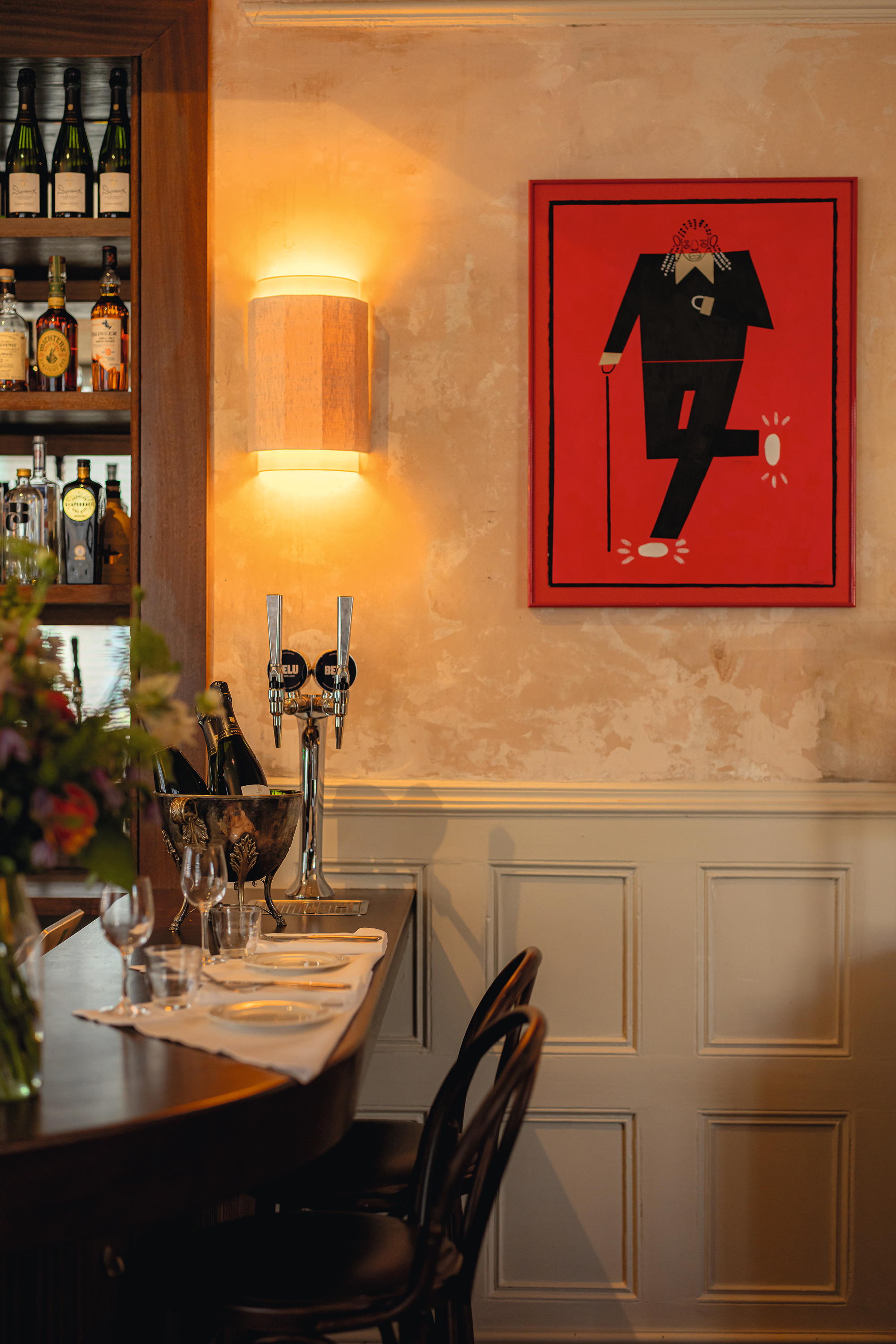The era of the £50 burger and chips is here — and it's a revelation
The second coming of the high-low restaurant — where chefs pair martinis with burgers — is here. Will Hosie tells more.


A new wave of restaurants is taking over the capital. They serve burgers, meatballs and beer on tap, together with martinis, cod’s roe and white asparagus. A purist might wince at such a mishmash of identities or imagine the sort of place that’s decked out in Farrow & Ball’s Elephant’s Breath and costs upwards of £50 a head without wine. One of those qualms is valid: expect to pay about £70, more if ordering cocktails.
Yet there’s none of the staid, unremarkable pallor of yesteryear’s fad restaurants, the sort that took themselves too seriously and requested that punters do the same. Instead of strangled chatter and flawless — sometimes soulless — service, the atmosphere is warm: think raw-plaster walls, panelled ceilings and candlelit tables.
A high-low restaurant’s menu is reassuringly expensive and its atmosphere is unsnobby. Chefs aren’t afraid to pair dishes from the American diner with those more often seen in Michelin institutions. The onus is placed not on groundbreaking cuisine, but on having a Good Time.

A bartender mixes a drink at The Dover, where owner Martin Kuczmarski asked the designers to imagine the sort of place where ‘Sophia Loren goes to eat a bowl of spaghetti meatballs, and Al Pacino is her boyfriend’.
Benjy Leibowitz, who co-owns One Club Row in Shoreditch, E1, traces this evolution back to New York, US, where he cut his teeth at The NoMad, a luxury hotel in Manhattan. ‘Londoners have traditionally gone out for dinner because they’re looking for culinary excellence,’ he explains. ‘Something they couldn’t make for themselves at home. In New York, the main reason why people go out for dinner is to have fun.’
The dining scene in the Big Apple is less specialised than it is here. The emphasis is less on unique fusions and original recipes than it is on curating a mood that caters to the widest audience — more democratic than London establishments such as St John, EC1, or Kiln, W1. Yet in the current political and economic climate, Mr Leibovitz says, Londoners are taking a leaf out of the Yankee playbook. In search of escapism, vibes have taken over haute cuisine as the primary compulsion for dining out. ‘What we’re witnessing,’ he explains, ‘is a move away from super-creative, chef-led kitchens and a return to dining out as a more holistic experience, with fun rooms and classic menu items.’
One can still make a compelling case for St John as the original high-low restaurant. Fergus Henderson’s Smithfields institution, which pioneered the nose-to-tail movement long before it became trendy, has enjoyed a cult following since it opened in 1994. Mr Leibovitz calls it the ‘patient zero’ of high-low restaurants: somewhere that was all about ‘stripping away the fuss’ and finding flair in simplicity. ‘No tablecloths, no garnishes and whitewashed walls,’ he muses. ‘It doesn’t get barer than that.’ His own restaurant, by contrast, is more ‘maximalist’. The walls at One Club Row are an earthy shade of pink and adorned with paintings by the artist Joy Yamusangie, as a pianist plays tunes in the background. ‘For me, it’s as much about creating beautiful spaces with good lighting — and with laughter and joy in the room — as it is about good food and drinks,’ Mr Leibovitz says.

Classic food, nimbly executed: The Hero, a gastropub with a specialist restaurant on the first floor, is one of the hottest tables in town.
There are clear economic motives for such an approach. Restaurants have struggled to cope with falling demand amid the cost-of-living crisis and were dealt another blow when the Budget changes came into force in April, reducing relief on business rates and raising employer national-insurance contributions to 15%. It is in every restaurateur’s interest to build customer loyalty.
Exquisite houses, the beauty of Nature, and how to get the most from your life, straight to your inbox.
Chef-led restaurants — typically expensive and reserved for special occasions — can struggle to woo diners time and again. Their menus are seasonal, changing monthly or sometimes weekly. This can be a problem for the average punter in search of a reliable, straightforward establishment — which, if not a neighbourhood restaurant in the strictest sense, feels like one. Menus at The Dover and The Pelican change only a little from one season to the next; what’s more, Mr Leibovitz notes, they are ‘multi-occasion’. As for his own place, he wants you to be able to come there ‘on a date night, with your parents, with your colleagues or with your friends’.

At Bambi in Westgate Street, DJs spin vinyls as the chef plates up sea-bass ceviche paired with natural wines.
London is moving away from academic dining towards a scene in which menus warrant neither explanation nor alarm — and are noticeably more eclectic than those of St John or its sister restaurant, Margot Henderson’s Rochelle Canteen, E2. Although the food there is certainly delicious, the almost dogged commitment to British recipes feels increasingly at odds with a more and more imaginative clientele. Although the Hendersons’s restaurants have done an artful job of elevating previously undesirable dishes — think bone marrow and other offal — they mine inspiration from a singular source: namely, the English farm. This year’s openings have, so far, been more notable for their eclecticism. The vogue for specialist dining, for pure Britishness or pure Frenchness, is subsiding. Whereas multifaceted menus used to inspire panic — how can the same kitchen produce both a showstopping tuna crudo and a smashing schnitzel? — they now inspire confidence.
It is easy to bemoan such variety as a cop-out, an attempt to satisfy all palettes. A friendlier outlook might compliment our newer chefs for taking such tasteful risks — but even that is a red herring, Mr Leibovitz says, as today’s high-low restaurants are instead about comfort and regularity: the culinary equivalent of pairing Gucci loafers with Levi jeans. They are the sort of place where well-heeled customers will comfortably pay the better half of £100, but aren’t so precious they couldn’t feasibly spill red wine down their shirt after having one too many.

A painting by the artist Joy Yamusangie hangs next to the bar at One Club Row. Benjy Leibovitz says he wanted to create somewhere people come back to again and again.
There are, of course, common threads between the old and new high-low. For interior designer George Morgan, the material most emblematic of the high-low restaurant in all its declensions is stainless steel. ‘It lives in a world of 1950s Spanish bars, where a counter top runs front to back through a skinny building, with a pole as a footrest,’ he explains. ‘It’s the world of jellied eels, pickled gherkins and small beers: practical but also stylish.’
London’s new high-low restaurants
Prices per person, including wine
- The Dover
33, Dover Street, W1; 020–3327 8883
www.thedoverrestaurant.com
About £80 - The Hero
55, Shirland Road, W9; 020–3432 1514
www.theherow9.com
About £70 - Bambi
1, Westgate Street, E8; 020–3822 0301
www.bambi-bar.com
About £70 - Albers
23a, Englefield Road, N1; bookings@albers.london
www.albers.london
About £50 - Bistro Freddie
74, Luke Street, EC2; 020–8050 0374
www.bistrofreddie.com
About £80 - One Club Row
1, Club Row, E1; hello@oneclubrow.com
www.oneclubrow.com
About £80 - Brutto
35–37, Greenhill Rents, EC1; 020–4537 0928
https://msha.ke/brutto
About £60 (negronis from £5)
This is as true of Rochelle Canteen as it is the similarly christened Canteen, W10, one of 2024’s overnight successes and a place so popular it doesn’t take reservations. Whereas Rochelle Canteen takes last orders at 7.45pm, Canteen is open until 1am on Thursdays. One Club Row, for its part, welcomes new punters until 10pm — and doesn’t shut up shop before midnight.
Acclaimed restaurateur Jeremy King is another key figure in this latest high-low development. He is at the helm of London’s brasserie renaissance, having opened the smash hit Arlington, W1, and the equally lauded Park, W2, last year. In April, both restaurants introduced a scheme whereby 25% is taken off the total bill for diners sitting down after 9.15pm (9pm on Sundays). As Mr King eyes the opening of his latest venture, a revival of Simpson’s in the Strand, he and others are bringing back late, European-style dining to the capital. It comes as the borough of Camden green-lights plans to extend opening hours for pubs and clubs. Like Mr Leibovitz, Mr King is a former maître d’: someone whose establishments trade on the art of connection. It’s not enough to simply captivate the audience. One has to keep it, too.
This evolution can be traced back to New York, as well — and, in further evidence that London is following in tow, one of the Big Apple’s favourite restaurants, Carbone, is opening its first outpost in the Big Smoke later this year at the Chancery Rosewood, W1. Although Carbone is indisputably high-end, it’s also far cosier than what we once imagined someone meant when they said ‘upscale restaurant’. Pasta is served on authentic Neapolitan plates. White tablecloths contrast with dim candlelight. Vintage and contemporary artworks hang on the walls, including retro Italian movie posters and framed family photos. Over at Claridge’s, W1, another Manhattan institution, the aperitivo cocktail bar Dante, is taking over the main restaurant for a month from June 30. Its menus include one for brunch and one for ‘Martini Hour’. It taps into precisely the high-low mix that Londoners have come to crave.
The new high-low is about far more than pairing a burger with a martini, although that’s certainly a good starting point and perhaps even a useful metaphor. Indeed, London’s love affair with the high-low is omnivorous: the allure of a drink favoured by James Bond and Leonardo DiCaprio’s Jay Gatsby is as compelling as the basic, yet universally dependable burger. It’s about challenging the idea that certain foods — and certain vibes — belong in certain places, checking in your prejudice at the door and enjoying something for the sheer pleasure of it.
Will Hosie is Country Life's Lifestyle Editor and a contributor to A Rabbit's Foot and Semaine. He also edits the Substack @gauchemagazine. He not so secretly thinks Stanely Tucci should've won an Oscar for his role in The Devil Wears Prada.
